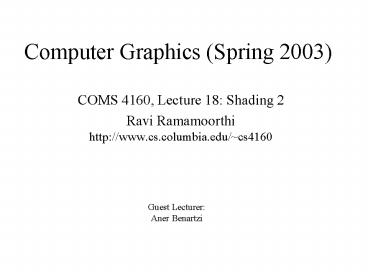Computer Graphics (Spring 2003) - PowerPoint PPT Presentation
1 / 20
Title:
Computer Graphics (Spring 2003)
Description:
Computer Graphics (Spring 2003) COMS 4160, Lecture 18: Shading 2 Ravi Ramamoorthi http://www.cs.columbia.edu/~cs4160 Guest Lecturer: Aner Benartzi ... – PowerPoint PPT presentation
Number of Views:102
Avg rating:3.0/5.0
Title: Computer Graphics (Spring 2003)
1
Computer Graphics (Spring 2003)
- COMS 4160, Lecture 18 Shading 2
- Ravi Ramamoorthi
- http//www.cs.columbia.edu/cs4160
Guest Lecturer Aner Benartzi
2
Building up the BRDF
- Bi-Directional Reflectance Distribution Function
- Function based on viewing direction.
- Tells us how bright a surface is.
- Why should a surface be bright?
- Incoming Hemisphere
- Incoming Intensity
- Relates incoming light energy to outgoing light
energy.
3
Function of Viewing direction
- A direction in 3-D, in relation to a point on a
surface, can be given with 2 angles - ,
- same as the angles in spherical coordinates
- r is not needed for direction only
4
Solid Angels
- Not enough to view an object from a single line
of sight. - infinitesimally small viewing area leads to 0
incoming energy. - need a range of directions.
- In 2D the span of directions is an angle.
- In 3D the equivalent value is a solid angle
5
Differential Solid Angles
6
BRDF as a Ratio
- Just a ratio of the incoming light to the
outgoing light. - 4D function.
7
The Reflection Equation
8
Brdf Viewer plots
Diffuse
Torrance-Sparrow
Anisotropic
bv written by Szymon Rusinkiewicz
9
Incoming vs. Outgoing Energy
- Desirable properties of BRDF
- Ratio between Zero and One.
- Linear
- Reciprocity (Hemholtz reciprocity)
10
Properties of BRDFs
11
Emperical BRDF
- Sample many incoming and outgoing directions.
- Store the results in a 4D data structure
12
Analytical BRDF TS example
- One famous analytically derived BRDF is the
Torrance-Sparrow model. - T-S is used to model specular surface, like the
Phong model. - more accurate than Phong
- has more parameters that can be set to match
different materials - derived based on assumptions of underlying
geometry. (instead of because it works well)
13
Torrance-Sparrow
- Assume the surface is made up grooves at the
microscopic level. - Assume the faces of these grooves (called
microfacets) are perfect reflectors. - Take into account 3 phenomena
Masking
Interreflection
Shadowing
14
Torrance-Sparrow Result
Geometric Attenuation reduces the output based
on the amount of shadowing or masking that occurs.
Fresnel term allows for wavelength
dependency (ignore for now)
Distribution distribution function determines
what percentage of microfacets are oriented to
reflect in the viewer direction.
How much of the macroscopic surface is visible to
the light source
How much of the macroscopic surface is visible to
the viewer
15
Other BRDFs
- Toon Shaders
- view independent
- discrete in lighting dependance
- Anisotropic
- some BRDFs depend on the orientation of the
surface. - Hair, Brushed Steel
16
Anisotropic vs. Isotropic
- The 4D BRDF weve seen so far can handle
anisotropic surfaces. - Most surfaces are isotropic
- Appear the same when rotated about the normal
- The overall orientation in the phi direction
doesnt matter - only need to worry about the difference between
- BRDF becomes a 3D function
17
Complex Lighting
- So far weve looked at simple, discrete light
sources. - Real environments contribute many colors of light
from many directions. - The complex lighting of a scene can be captured
in an Environment map. - Just paint the environment on a sphere.
18
Environment Maps
- Instead of determining the lighting direction by
knowing what lights exist... - Determine what light exists by knowing the
lighting direction.
Blinn and Newell 1976, Miller and Hoffman,
1984 Later, Greene 86, Cabral et al. 87
19
Limitations
- Carefully constructed BRDFs can create very
realistic scenes. A good BRDF alone still has
limitations - The silhouettes of objects are still polygonal.
- The resolution of surface normals is only as fine
as the number of polygons. - Can use bump maps
- Nothing takes into account objects shadowing
themselves. - Can use shadow maps
20
Limitations (cont)
- More limitations of modeling appearance only with
a BRDF - Any reflections or transparency cant include
other scene objects. - requires ray-tracing
- Sometimes light leaves a different point from the
one it entered (subsurface scattering). - Some objects contribute significantly to the
lighting in the scene. - requires global illumination































